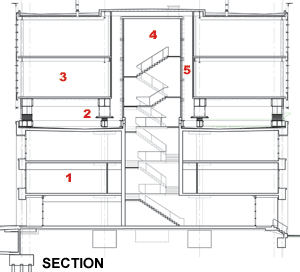Three Buildings, Three Different Approaches
Less invasive surgery
In China Basin, along San Francisco's southern waterfront, structural engineers from Simpson Gumpertz & Heger (SGH) and architects from HOK faced a not-so-dissimilar design problem from that posed by 680 Folsom: The owners of a three-story, 300,000-square-foot building wanted to expand but were limited by the seismic capacity of the existing concrete structure. However, the client, real estate investment firm McCarthy Cook, had one additional, and significant, requirement: Construction could not disrupt the operations of the bioscience laboratories that already occupied the building.
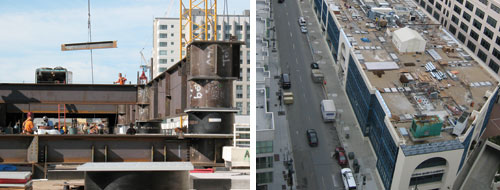 |
|||
In San Francisco's Photos courtesy Simpson Gumpertz & Heger |
 |
||
|
|||
The restriction made construction of shear walls, a solution similar to that proposed for the vacant 680 Folsom, an impossibility, since the strategy could not be deployed without displacing the tenants from the mid-1980s structure. So, to avoid invasive interior construction, the firms devised an alternative approach that included two new steel-framed stories over the roof of the existing building, on top of a system of seismic isolation bearings. At 150,000 square feet, the addition would be three times the size of the one the building had been originally designed to accept.
Bearings like those at China Basin are typically used under structures, for both retrofit applications and new buildings. But SGH engineers say the project, completed last spring, is the first in the U.S. to incorporate seismic isolators in a location other than the base of a building and in conjunction with a vertical addition.
Implementation of the strategy required only minimal construction on the lower floors, to strengthen columns so that they could accept the increased gravity loads. But even without major interior retrofit work, the addition "made the existing building better from a seismic standpoint," says John Sumnicht, a senior principal in SGH's local office. The new floors act like a mass damper. "During strong earthquake shaking, the new stories will tend to counterbalance the movement of the lower floors and actually reduce the amount of seismic forces and displacement demand on the existing structure," he says. The isolation system is designed to allow the addition to move as much as 45 inches in either direction relative to the existing structure below-1.5 times the displacement required by code.
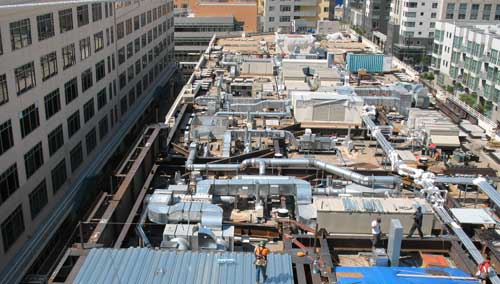 |
|
| The density mechanical equipment mounted on the old building's roof (top) made coordination between building services and the isolator system challenging for designers and contractors. | |
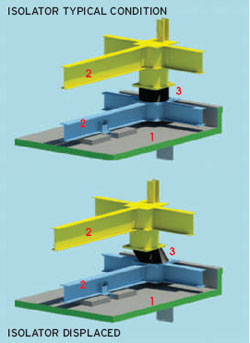 |
During a powerful temblor, the China Basin addition will move on top of 87 isolators (left), sandwiched between two grids of steel beams (bottom). 1. Existing roof |
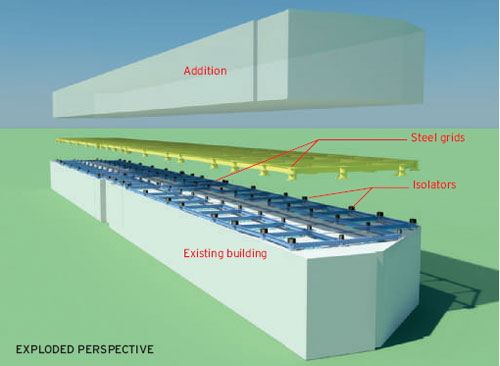 |
|
| Photo and diagrams courtesy Simpson Gumpertz & Heger | |
The isolators, 87 in total, are positioned on top of the existing building's columns and sandwiched between two grids of steel beams. The system is made up of 33 lead-rubber bearings, and 54 elastomeric slider bearings. The two types are combined, explains Sumnicht, in order to tune the structure's period-the time it takes the addition to move from center, to the extreme right, to the extreme left, and back to center again. Lead-rubber bearings alone would make the period too short; replacing some of these with sliders lengthens the period, he says. "This is one of the ways seismic isolation works. When the period is lengthened, the building isn't shaken so violently."
Because the existing building is a lab, it had a high-concentration of roof-mounted mechanical equipment and utilities. Designers needed to closely examine clearances around isolators so that they would not have the potential of colliding with, and damaging, utilities during a quake. Contractors also had to take special care not to disrupt building services during construction. "Coordination at the roof level was a nightmare," says Sumnicht.
For the architects, the biggest challenge was design of vertical circulation-the locations where core elements, such as stairs and elevators, extend through the new construction. "In order to accommodate movement, we had to consider what would connect to the existing construction and what connects to the new construction," says Mark Borchardt, AIA, senior associate in HOK's local office. In the end, the architects decided to extend the cores from the existing building and surround them by a 36-inch moat to prevent core elements from crashing into surrounding construction during a temblor. A tunnel-like device that allows movement in any horizontal direction bridges the moat and connects the cores to the new floor plates.





